KABBALAH
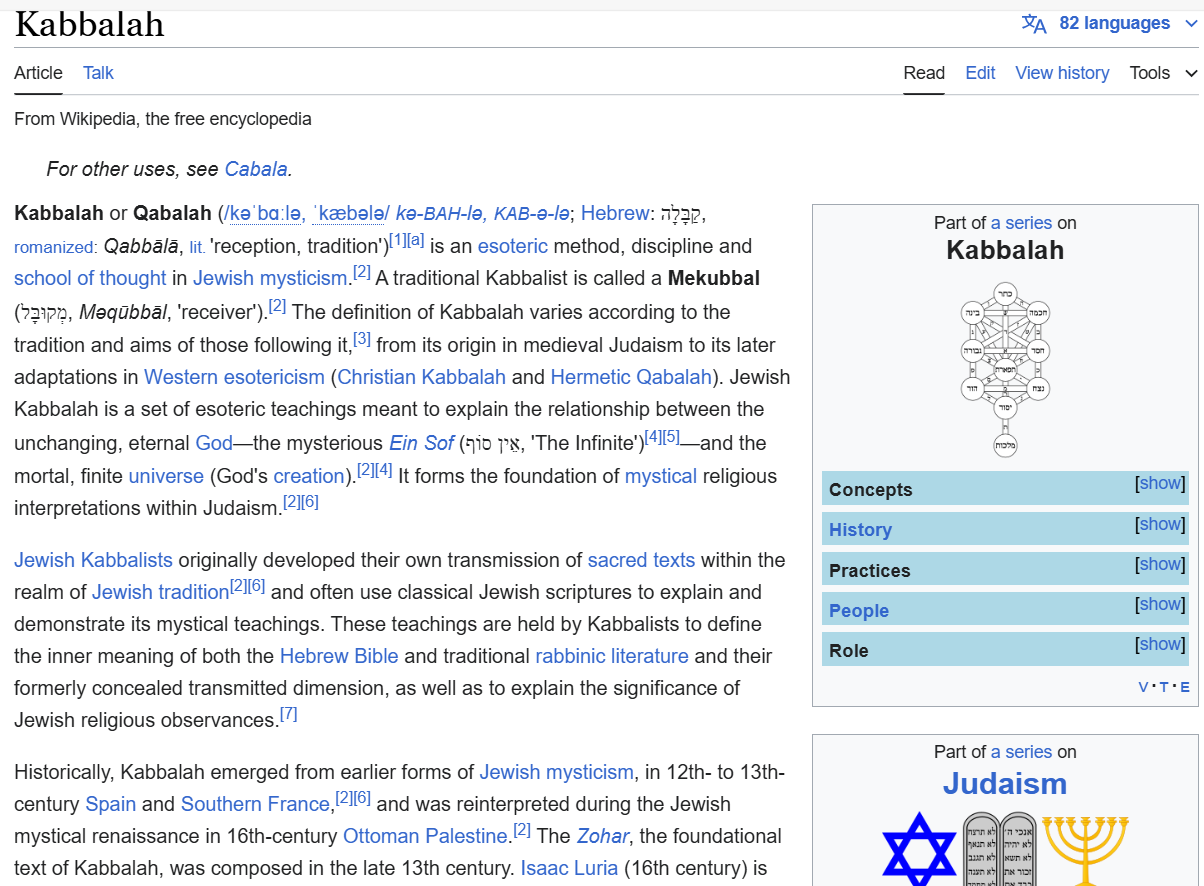
Kabbalah (Hebrew: קַבָּלָה Qabbālā, literally "reception, tradition"[1] or "correspondence"[2]: 3 ) is an esoteric method, discipline and school of thought in Jewish mysticism.[3] A traditional Kabbalist in Judaism is called a Mekubbal (מְקוּבָּל Məqūbbāl).[3] The definition of Kabbalah varies according to the tradition and aims of those following it,[4] from its origin in medieval Judaism to its later adaptations in Western esotericism (Christian Kabbalah and Hermetic Qabalah). Jewish Kabbalah is a set of esoteric teachings meant to explain the relationship between the unchanging, eternal God—the mysterious Ein Sof (אֵין סוֹף, "The Infinite")[5][6]—and the mortal, finite universe (God's creation).[3][5] It forms the foundation of mystical religious interpretations within Judaism.[3][7]
Jewish Kabbalists originally developed their own transmission of sacred texts within the realm of Jewish tradition[3][7] and often use classical Jewish scriptures to explain and demonstrate its mystical teachings. These teachings are held by Kabbalists to define the inner meaning of both the Hebrew Bible and traditional rabbinic literature and their formerly concealed transmitted dimension, as well as to explain the significance of Jewish religious observances.[8]
Traditional practitioners believe its earliest origins pre-date world religions, forming the primordial blueprint for Creation's philosophies, religions, sciences, arts, and political systems.[9] Historically, Kabbalah emerged from earlier forms of Jewish mysticism, in 12th- to 13th-century Spain and Southern France,[3][7] and was reinterpreted during the Jewish mystical renaissance in 16th-century Ottoman Palestine.[3] The Zohar, the foundational text of Kabbalah, was composed in the late 13th century. Isaac Luria (16th century) is considered the father of contemporary Kabbalah; Lurianic Kabbalah was popularised in the form of Hasidic Judaism from the 18th century onwards.[3] During the 20th century, academic interest in Kabbalistic texts led primarily by the Jewish historian Gershom Scholem has inspired the development of historical research on Kabbalah in the field of Judaic studies.[10][11]
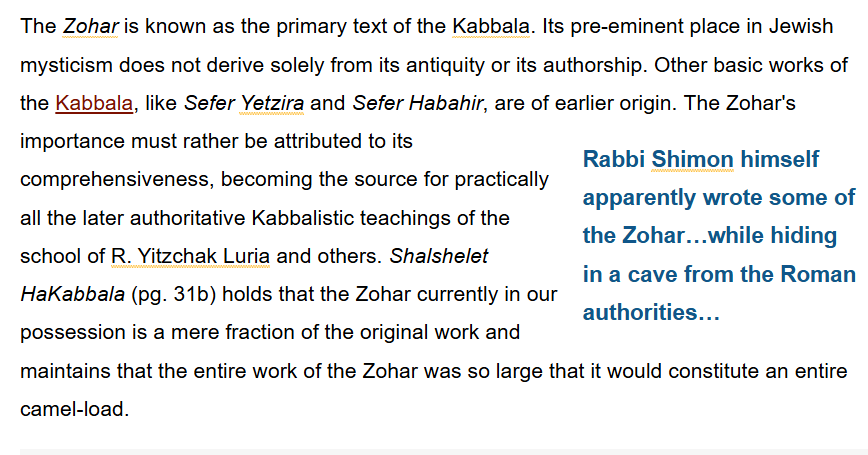
What Is the Zohar? - The Teachings of Rabbi Shimon bar Yochai - History of Kabbalah (chabad.org)
The Zohar is known as the primary text of the Kabbala. Its pre-eminent place in Jewish mysticism does not derive solely from its antiquity or its authorship. Other basic works of the Kabbala, like Sefer Yetzira and Sefer Habahir, are of earlier origin. Rabbi Shimon himself apparently wrote some of the Zohar…while hiding in a cave from the Roman authorities…The Zohar's importance must rather be attributed to its comprehensiveness, becoming the source for practically all the later authoritative Kabbalistic teachings of the school of R. Yitzchak Luria and others. Shalshelet HaKabbala (pg. 31b) holds that the Zohar currently in our possession is a mere fraction of the original work and maintains that the entire work of the Zohar was so large that it would constitute an entire camel-load.
What Is the Zohar? - The Teachings of Rabbi Shimon bar Yochai - History of Kabbalah (chabad.org)
The Zohar was concealed for many centuries, as the study of the Kabbala was restricted to a select few qualified individuals. It became revealed only in the thirteenth century and was published by one of the leading kabbalists living in Spain, Rabbi Moshe de Leon. Some believed that the Ramban (Rabbi Moshe ben Nachman c. 1194-1270 CE), himself a renowned Kabbalist, had sent the Zohar from Israel by ship to his son in Catalonia, but the ship had been diverted and the texts ended up in the hands of Rabbi Moshe de Leon (Shem HaGedolim, Chida Sefarim, Zayin, 8). Others explained that these manuscripts had been hidden in a vault for a thousand years and had been discovered by an Arabian king who sent them to Toledo to be deciphered. Some maintained that Spanish conquistadors had discovered the manuscripts of the Zohar among many others in an academy in Heidelberg (Shem HaGedolim, ibid.). Other explanations have also been offered. The mystics ascribe special potency to the study of the Zohar: it effects a nullification of evil decrees, eases the travails of exile, hastens the redemption, and draws forth divine effluence and blessings (See R. Abraham Azulai, Foreword to Or Hachamah, p. 2d). There is great merit even in the mere recitation of the sacred texts of the Zohar, even though one does not understand them (R. Chaim David Azulai, Moreh Be'etzba II:43).
The Structure of the Zohar
Although the Zohar is generally referred to as a single multi-volume work, comprising Zohar, Tikunei Zohar and Zohar Chadash, it is actually a compilation of several smaller treatises or sub-sections - approximately twenty main sections. These are:
- The main bulk of the Zohar, sometimes also called Midrash HaZohar, written as commentary on sections and passages of the Torah.
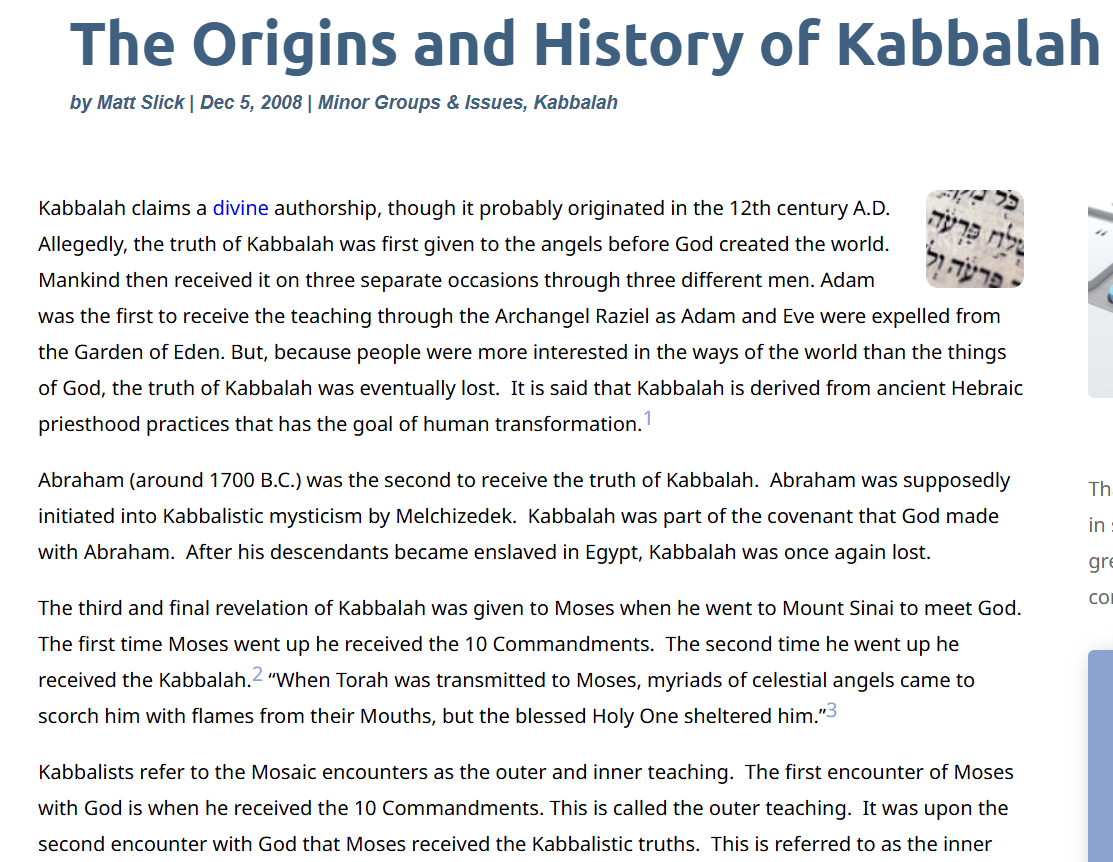
Kabbalah: A Brief Synopsis of Its Origins and History | carm.org
Moses De Leon, a 14th century Spanish Kabbalist presented the Zohar, an extremely influential book in Kabbalistic philosophy. De Leon originally claimed that he found the scrolls that had been written much earlier, more than a thousand years earlier. Recent scholarship supports the idea that he is the one who wrote the Zohar.
Present-day Kabbalah is said to have descended through John Dee (1527-1608) who was a mathematician and geographer and Isaac Luria (1534-1572) who he is commonly referred to as the greatest Kabbalist of modern times. Contributors were Chayim Vital (1543-1620), Shabbetai Zvi (1626-1676), Gaon of Vilna ( 1720-1797), Rabbi Ashlag (1886-1955), and others.
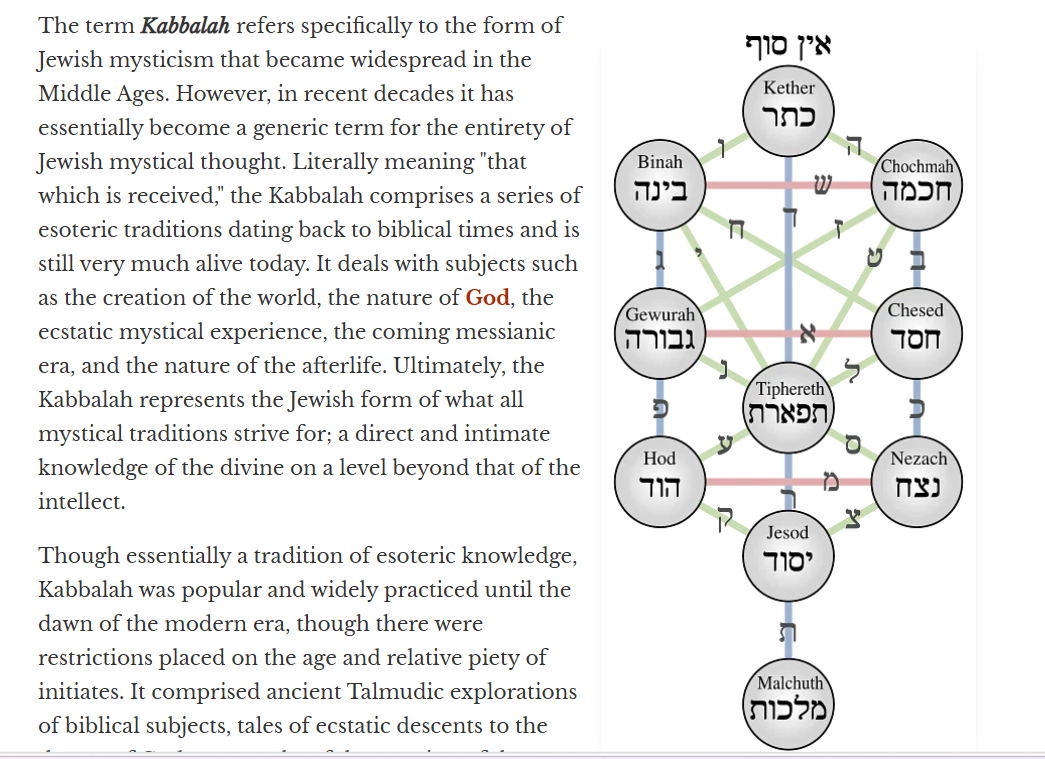
Kabbalah - World History Encyclopedia
The term Kabbalah refers specifically to the form of Jewish mysticism that became widespread in the Middle Ages. However, in recent decades it has essentially become a generic term for the entirety of Jewish mystical thought. Literally meaning "that which is received," the Kabbalah comprises a series of esoteric traditions dating back to biblical times and is still very much alive today. It deals with subjects such as the creation of the world, the nature of God, the ecstatic mystical experience, the coming messianic era, and the nature of the afterlife. Ultimately, the Kabbalah represents the Jewish form of what all mystical traditions strive for; a direct and intimate knowledge of the divine on a level beyond that of the intellect.
Though essentially a tradition of esoteric knowledge, Kabbalah was popular and widely practiced until the dawn of the modern era, though there were restrictions placed on the age and relative piety of initiates. It comprised ancient Talmudic explorations of biblical subjects, tales of ecstatic descents to the throne of God, vast myths of the creation of the world, intense messianic fervor, and forms of pietistic ritual and practice that gave birth to movements that still influence Judaism today.
In the wake of the haskalah, or Jewish Enlightenment, the Kabbalah came to be regarded by many Jews as at best an embarrassing relic of a more credulous time, and it fell into great disrepute among the newly secular Jews of Europe. Recently, however, the Kabbalah has experienced an enormous revival, with widespread secular and religious interest in it, and some schools reaching out to non-Jews in an unprecedented way.
--- The first work of literature that can be accurately described as proto-Kabbalistic in the formal sense is the Sefer Yetzirah or "Book of Creation." The time of its writing remains controversial, though it is likely post-Talmudic and unquestionably existed by the 10th century CE. Unlike its predecessors, the Sefer Yetzirah does not deal with the divine chariot, but rather the creation of the world. The extremely short and often highly cryptic text describes the creation as taking place through God's incantation of the letters of the Hebrew alphabet with the collaboration of ten sefirot (sephiroth) or "numbers," which are given vaguely anthropomorphic form.
As such, the Sefer Yetzirah marks the beginning of the Kabbalah as it is known today. Though it was eventually superseded by medieval works of much greater sophistication and length, the Sefer Yetzirah led to extensive mystical and philosophical speculation and appears to mark the first widespread and generally accepted form of systematic mysticism in the Jewish world.
--- The monumental Sefer HaZohar or "Book of Radiance" is the single most important text of the Kabbalah. The origins of the Zohar were initially unclear and aroused considerable controversy at the time. It emerged in the 1200s CE and was attributed to the ancient rabbi Simeon Bar Yochai, though modern scholars largely agree that it was primarily written by Moshe de Leon, a Spanish mystic, and/or a group of similar-minded mystics whose speculations were eventually collected and published by de Leon.
A massive work of well over 1,000 pages in printed editions, the Zohar is written in a pseudo-Aramaic dialect and proposes a far-reaching, epic cosmology that set the standard for Jewish mysticism in the ensuing centuries. Among its key concepts is that of the Tree of Life: the configuration of ten sefirot, which are conceived of as spheres or entities composing the various attributes of God. These sefirot are separate from the infinite unknowable essence of God, called the ain sof or literally "without end." They are identified with specific divine characteristics such as bina ("wisdom" or "understanding"), hesed ("mercy"), and gevurah ("strength"). At the same time, they represent parts of the divine body, such as hands and feet.
--- Most strikingly, the Zohar's cosmology contains an explicitly erotic element, with the sefirot of yesod ("foundation") and malchut ("kingship") representing the penis and vagina respectively, making God an intersex being who engages in a form of creative auto-eroticism, a concept that remains essential to later forms of Kabbalah. Equally important for later forms of Jewish mysticism was the idea that what transpires in the material world directly influences the divine world and vice versa: "The impulse from below calls forth that from above" (Zohar I, 164a). This gives humanity a highly active role in the work of the divine, influencing the world of the sefirot through study, religious ritual, prayer, and mystical practices.
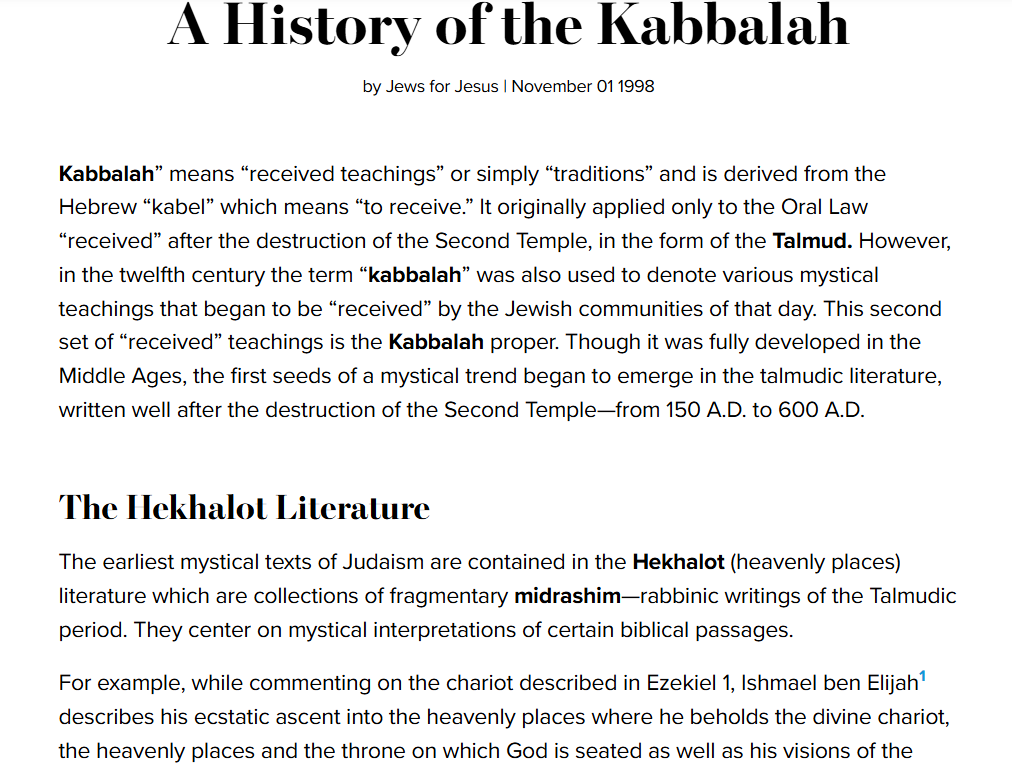
A History of the Kabbalah - Jews for Jesus
Neoplatonism and Gnosticism
Sepher Yetzirah was influenced heavily by neoplatonsim, a late Greek philosophical school that combined elements of Plato with Oriental belief systems. Plato believed that our physical world is not the primary place of existence. He posited a "higher" world where the true forms exist. Our world is, he thought, only a mirror of the true world "above." Sefer Yetzirah placed these ideas into a Jewish framework. The work was back-dated and its authorship ascribed (in typical Kabbalistic fashion) to an authoritative Jewish figure, in this case Abraham.
Gnosticism, another mystical trend of the time also influenced the Kabbalists. Gershon Sholem, one of the great modern scholars in the development of the Kabbalah defines gnosticism as "the possession of knowledge that cannot be obtained by ordinary intellectual means; the possession of a secret doctrine concerning the order of the celestial worlds and the means that provide access to it."2
Gnosticism puffed-up the place of the individual and emphasized that he or she must gain secret knowledge and develop personal power in order to discover the road to self-enlightenment. Although the Kabbalah never removed its adherents from the community-at-large, as other gnostic sects did, Kabbalists latched onto the personal-experiential appeal of gnosticism and grafted the idea into the Jewish context.
And so it can be seen that "from the Talmudic period forward, Jews cultivated profoundly rich and highly diverse forms of mysticism."3 With the rise of Islam and the consequent persecutions of the Jews, the religious center of the Jewish people shifted from Babylon to locations in Europe, specifically to Italy, Germany, Spain and France.
It was in twelfth and thirteenth century France and Spain that the Kabbalah finally came into its definitive expression. In his article on kabbalistic texts, scholar Lawrence Fine defines the term "Kabbalah" as "a specific historical movement which originated in the second half of the twelfth century in that area of southern France known as Provence, and in northern Spain in the thirteenth century."4
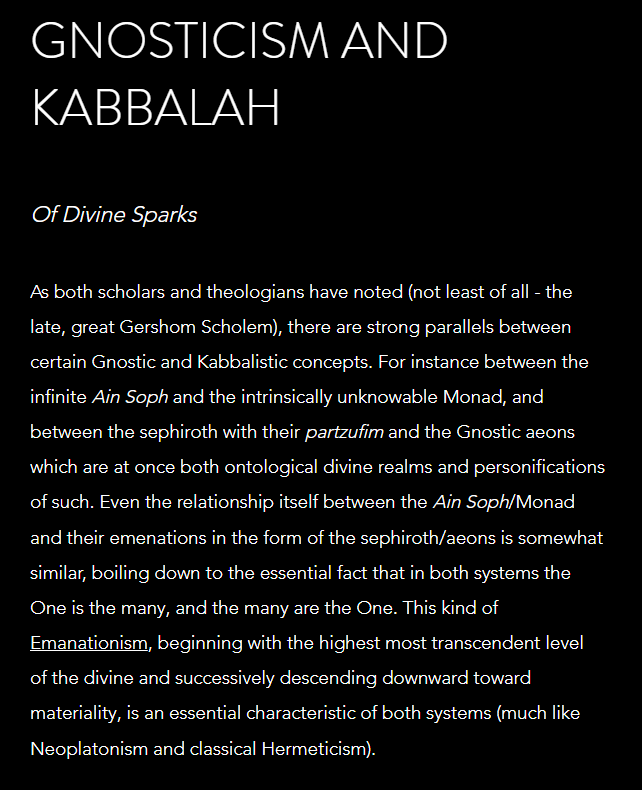
Gnosticism and Kabbalah | Gnosis for all
Of Divine Sparks
As both scholars and theologians have noted (not least of all - the late, great Gershom Scholem), there are strong parallels between certain Gnostic and Kabbalistic concepts. For instance between the infinite Ain Soph and the intrinsically unknowable Monad, and between the sephiroth with their partzufim and the Gnostic aeons which are at once both ontological divine realms and personifications of such. Even the relationship itself between the Ain Soph/Monad and their emenations in the form of the sephiroth/aeons is somewhat similar, boiling down to the essential fact that in both systems the One is the many, and the many are the One. This kind of Emanationism, beginning with the highest most transcendent level of the divine and successively descending downward toward materiality, is an essential characteristic of both systems (much like Neoplatonism and classical Hermeticism).
What is Kabbalah?
In the 12th and 13th centuries C.E., a mystical form of Judaism, called Cabala, started gaining popularity.
According to Cabalistic teachers, the simple meaning of the Bible text is not its true meaning. They believe that God used the individual letters of the Hebrew Bible text as symbols, which when properly understood reveal a greater truth. In their view, each Hebrew letter and its position in the Bible text was set by God with a specific purpose in mind.
The Jewish kabbalists had a system called athbash (Hebrew: אתבש; also transliterated Atbaš), whereby the first letter of the Hebrew alphabet is read as the last one, the second letter as the second to last letter.
The earliest documented Kabbalistic writing is called the Sepher Yetzirah, or the book of formation.
One tradition says that the Rabbi Akiva wrote it. He is supposed to be one of the greatest Kabbalists of all time.
Moses De Leon, a 14th century Spanish Kabbalist presented the Zohar, an extremely influential book in Kabbalistic philosophy. De Leon originally claimed that he found the scrolls that have been written much earlier, more than a thousand years earlier. Recent scholarship supports the idea that he is the one who wrote the Zohar.
--- The Zohar
The Zohar is one of the most important texts, if not the most important in Kabbalah. The Zohar is not a single book. Instead it is allegedly a 2nd century A.D. collection of Aramaic writings from various Kabbalists that is a commentary on the Torah: Genesis, Exodus, Leviticus, Numbers, and Deuteronomy with some commentary on the song of songs, also known as the song of Solomon. Its interpretations of the Torah are highly mystical and subjective and often in contradiction to what the Torah reveals. it seeks to explain as well as the video the relationship between God and man. But, the book is generally believed to have been authored by a 13th Century Jewish mystic named Moses De Leon (1250-1305) partly because it was never mentioned in the Talmud (a collection of commentaries used to explain the the oral law concerning the first five books of the Old Testament). Additions were added to the Zohar in the 14th century.
--- What are the main teaching of Kabbalah?
What are the main teaching of Kabbalah?
1. God has 10 aspects through which creation was realized.
1. God has 10 aspects through which creation was realized.
2. The the truths of Kabbalah were given to the angels first, then to Adam, then Abraham, and finally to Moses.
3. The human soul preexisted before coming to earth. cooper, 107.
4. Reincarnation of the soul.
5. Higher realms of consciousness
6. Multiple universes
7. The interconnectedness of all levels of consciousness, angels, demons, thoughts, incarnations, etc.
8. "There are four primary archangels: Michael, Gabriel, Uriel, and Raphael. (Cooper, David A., God is a Verb. New York, New York: Riverhead Brooks, 1997, p. 135.)
1. "Liliel is the Angel of the Night...Lilith is considered to be the arch she-devil." Sandalphon is the angel of prayer as is Michael, (Cooper, p. 135)
9. There are two Messiahs, one from the lineage of Joseph and the other from David, (cooper, p. 181.
10. The fall of Adam and Eve was because they failed to make a rectification that would bring "the universe to a new level of consciousness." cooper, 107
11. It is possible to have a direct experience with God without the need of a mediator such as Jesus
--- Gnostic ideas found a Jewish variation in the mystical study of Kabbalah. Many core Gnostic ideas reappear in Kabbalah, where they are used for dramatically reinterpreting earlier Jewish sources according to this new system The Kabbalists originated in 13th-century Provence, which was at that time also the center of the Gnostic Cathars.
Sethian Gnosticism was always anti-Jewish, even when it arose among Jews or Jewish Christians, for its radical dualism of an alien God set against an evil universe is a total contradiction of the central Jewish tradition, in which a transcendent God allows Himself to be known by His people as an immediate presence, when He chooses, and in which His creation is good except as it has been marred or altered by man's disobedience or wickedness.
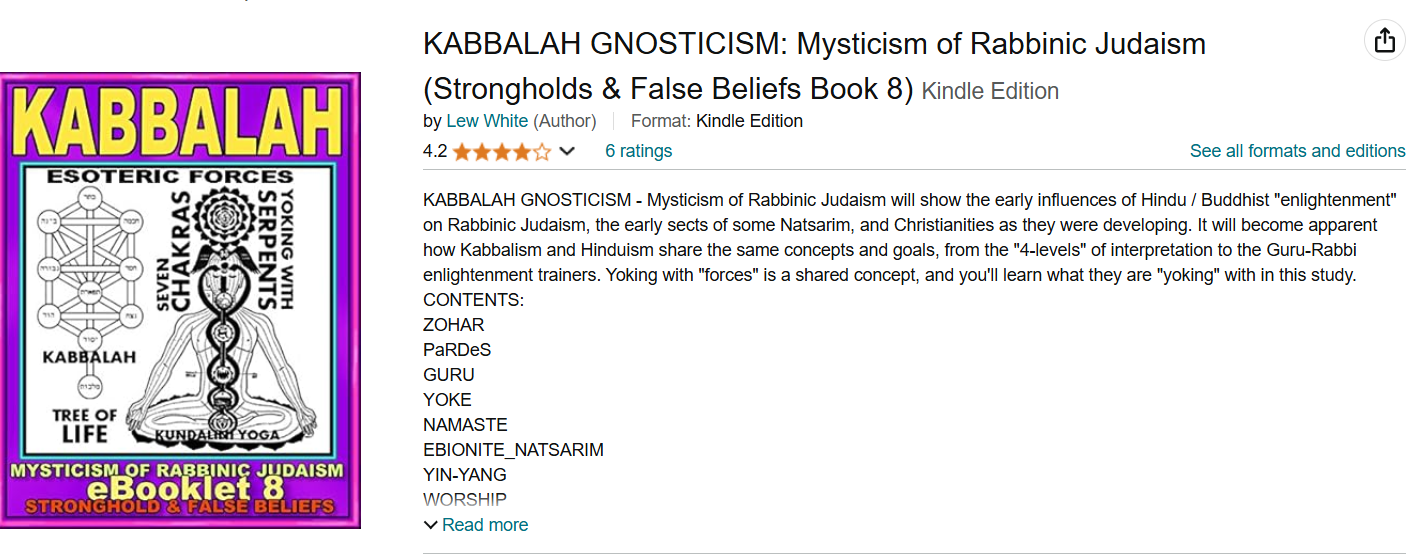
KABBALAH GNOSTICISM: Mysticism of Rabbinic Judaism (Strongholds & False Beliefs Book 8)
KABBALAH GNOSTICISM - Mysticism of Rabbinic Judaism will show the early influences of Hindu / Buddhist "enlightenment" on Rabbinic Judaism, the early sects of some Natsarim, and Christianities as they were developing. It will become apparent how Kabbalism and Hinduism share the same concepts and goals, from the "4-levels" of interpretation to the Guru-Rabbi enlightenment trainers. Yoking with "forces" is a shared concept, and you'll learn what they are "yoking" with in this study.
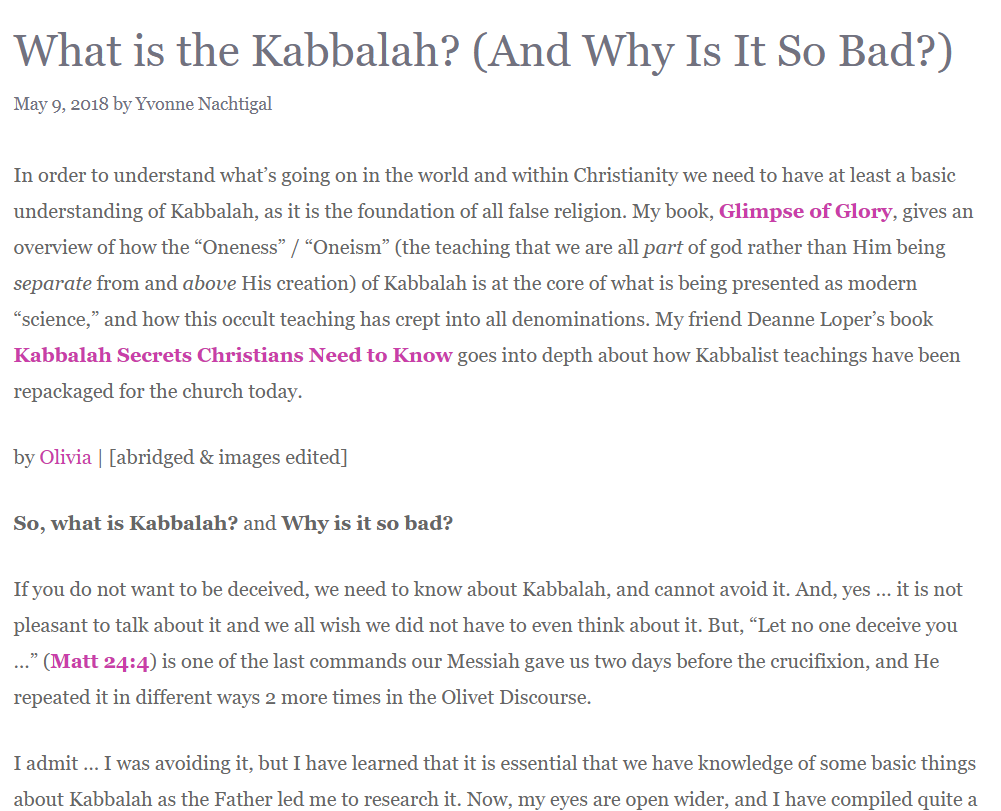
What is the Kabbalah? (And Why Is It So Bad?) - Christian Observer
Kabbalah is the mysticism that Freemasonry is based on, and they are inseparable. The kabbalists completely have taken over the secret society several hundreds of years ago, and are using it to control the world now. They worship the same gods. The secret society is a system and order of controlling the participants through Kabbalah. You may think of Kabbalah as the software, and Freemasonry as one of the hardware to use it and deliver it.
--- The Origin of Kabbalah
So, we have learned that Solomon worshiped the pagan gods of the surrounding nations, and they were also the origin of the mysticism and the esoteric knowledge of Freemasonry. And those famous occultists are testifying to the fact that Freemasonry is based in Kabbalah. These facts, then, bring us to the following conclusion:
Kabbalah, paganism, and Freemasonry are practically the same mysticism, worshipping of the same gods, which are Lucifer and the fallen angels. They are the religions of Ammonites, Amalekites, and other Canaanites, and even Egyptians, the serpent people. And, the origins of those pagan religions goes back to … you guessed it correctly: Babylon.
1 Kings 11:1-5
(1) But King Solomon loved many foreign women, as well as the daughter of Pharaoh: women of the Moabites, Ammonites, Edomites, Sidonians, and Hittites– (2) from the nations of whom the LORD had said to the children of Israel, “You shall not intermarry with them, nor they with you. Surely they will turn away your hearts after their gods.” Solomon clung to these in love. (3) And he had seven hundred wives, princesses, and three hundred concubines; and his wives turned away his heart. (4) For it was so, when Solomon was old, that his wives turned his heart after other gods; and his heart was not loyal to the LORD his God, as was the heart of his father David. (5) For Solomon went after Ashtoreth* the goddess of the Sidonians, and after Milcom** the abomination of the Ammonites.
--- the deities that Solomon ended up worshiping, and causing the kingdom to split, were the gods of Babylon, or often called Sumer or Sumeria, where Nimrod built the Tower of Babel and the current worldly civilization began.
All false religions are worshipping Lucifer and fallen angels, in one way or another, or worshipping even “man” themselves, by believing that they can become gods by obtaining certain esoteric knowledge and methods, or some hard work, even sacrificing their own children. And, from what we can observe, the Illuminati elites seem to think they are almost gods.
--- Gnosticism goes hand in hand with Cabala (Kabbalah or Qabbala), which is the esoteric or mystic religion of Rabbinic Judaism. These occult teachings deal with magic, hypnotism, sorcery and all sorts of pagan practices collected by the Jews throughout centuries of spiritual borrowing from different cultures. The mixing of all these pagan traditions with the teachings of the Gospel of Christ gave birth to a whole new kind of Gnostic religion called Jewish-Christianity, which is nothing else than a third religion between Judaism and Christianity. As a result, modern “Christianity” was turned into a gamma of Gnostic teachings with all sorts of perverted doctrines introduced throughout the centuries in most of the “Christian” denominations around the world.
“The result of Gnosticism was thus not to christianize the Cabala, but to cabalize Christianity by mingling its pure and simple teaching with theosophy and even magic.” (Nesta H, Web ster (1876 – 1960), Secret Societies and Subversive Movements, p.29, 1924)
--- Worship of Man and Self
There is another aspect of Kabbalah we need to know.
Manly P, Hall, a 33rd Degree Mason, an infamous occultist said this:
“Man is a god in the making, and as in the mystic myths of Egypt, on the potter’s wheel he is being molded. ….. He [The Master Mason], in truth has become the spokesman of the Most High. He stands between the glowing fire light and the world. Through him passes Hudra, the great snake, and from its mouth there pours to man the light of God.” (The Lost Keys of Freemasonry, Manly P. Hall, pages 92, 54-55, Macoy Publishing and Supply Co., Richmond, Va, 1976)
--- And, the core nature of kabbalistic Judaism is the same as the Freemasonry, exactly the same. They worship themselves first, and Lucifer, to fulfill their desire to become gods, because that is how Lucifer draws and controls them. The esoteric knowledge one needs to become enlightened (or ‘illuminated’) and deified is the carrot in front of the horse’s nose, which one can never get, even in exchange for his soul. They want the everlasting life in this world with all the amenities with it: wealth, control, and worldly pleasure
Scholarly efforts to compare Hinduism and Judaism were popular during the Enlightenment era, in the process of arguing the deistic worldview.[1] Hananya Goodman states that Hinduism and Judaism have played an important role in European discussions of idolatry, spirituality, primitive theories of race, language, mythologies, etc.[2]
Both religions were regarded by some scholars to be ethnic religions, and not promoting conversions. Adherents of both religions, however, are found across the world.[3] Both religions share common elements in regard to a complicated system of laws, purity codes, and dietary restrictions, for defining their communities.[4]
Judaism has been compared with Hinduism by Osho Rajneesh[5] and Steven Rosen in their books. They cite the similarities between Brahmins and Jews who viewed themselves as "God's chosen people." Rosen adds that Brahmins had a "community of priests" while Jews had a "Kingdom of Priests".[6]
David Flusser says that the tale of Abraham has many similarities with a certain story from the Upanishads, stating that "One can easily discover parallels in the Upanishads to the Abraham legend".[7][8]
American biologist Constantine Samuel Rafinesque (1783-1840) in his book The American Nations discusses linguistic and traditional similarities between the two religions. In one chapter he writes:
"Our Noah- is thus NH (pr NOE) which the Jews since pronounced NUH, and even Mnuh! Exactly the same name as given him by the Hindus! And all meaning repose, with many collateral meanings, lawgiver, collecting people, assembly humanity & c. The laws of M'nu are preserved by the Hindus : to him is also ascribed the substance of the Vedas, and the whole Mosaic history till near his own death. But the Hindus have many- M'nus; Adam and Seth were such, by the names of Adimo and Satya."[9]
--- Ancient trade and cultural communication between India and the Levant is documented in the Periplus of the Erythraean Sea and the accounts surrounding the Queen of Sheba in the Hebrew Bible.
Bhavishya Purana is regarded by a number of scholars to have predicted Judaism's prophet Moses, and similar parallels are found in the Vedas.[19]
The trade relations of both communities can be traced back to 1,000 BCE and earlier to the time of the Indus Valley civilisation of the Indian subcontinent and the Babylonian culture of Middle East. A Buddhist story describes Indian merchants visiting Baveru (Babylonia)[20] and selling peacocks for public display. Similar, earlier accounts describe monkeys exhibited to the public.[21]
The Torah has also been helpful for understanding relations between these two traditions.[22] Geographical analysis of Israel suggests that the authors of Torah were talking about India, where the selling of animals such as monkeys and peacocks existed.[23] Trade connections between India and Mediterranean Jewish communities continued, and later, the languages of these cultures started to share linguistic similarities.[24]

Strange Bedfellows: Hinduism and Judaic Mysticism in Comparison (apocryphile.org)
If ever there were strange bedfellows in the field of religion, Hinduism and Judaism are two of the strangest. While there is an abundance of material comparing Christianity and Hinduism, I don't believe I've ever encountered an article or a volume devoted to Hindu-Jewish dialog. No doubt this is due to their initial seeming dissimilarity. I cannot think of two more divergent systems, yet, as often happens, the closer we look, the more things begin to look familiar.
In both cases we begin with what Michael H. Barnes calls the "archaic" period of religious development. He describes this as a time when "towns with class structure in a larger world, with great and distant gods demanding worship; grand myths; dreams of idealized earthly life; acceptance (and taboo) morality."1 This describes both cultures well. For both the aboriginal Indian and the Abrahamic Semite, the gods were many, and distant. Fate was manipulated by appealing to the gods sacrificially, and the oldest of scriptures in both traditions are those dealing most especially with the protocol of sacrifice.